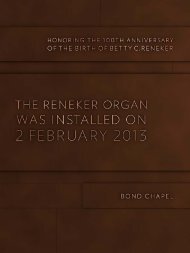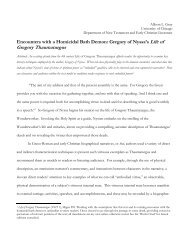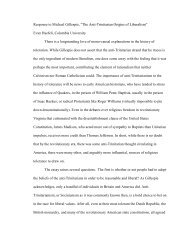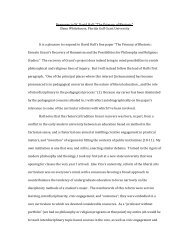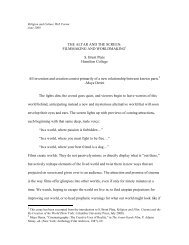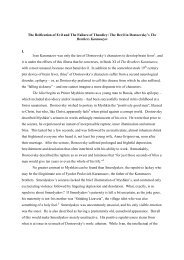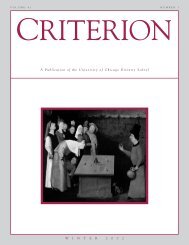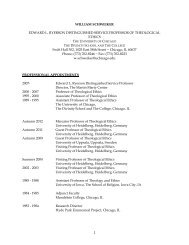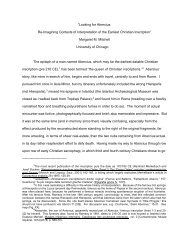Housing the Dead: the tomb as house in Roman Italy - Divinity School
Housing the Dead: the tomb as house in Roman Italy - Divinity School
Housing the Dead: the tomb as house in Roman Italy - Divinity School
You also want an ePaper? Increase the reach of your titles
YUMPU automatically turns print PDFs into web optimized ePapers that Google loves.
22<br />
<strong>the</strong> f<strong>in</strong>ds are genu<strong>in</strong>e, not a n<strong>in</strong>eteenth century fake <strong>as</strong>sembled to order for <strong>the</strong> market by those who<br />
well knew <strong>the</strong>ir Pl<strong>in</strong>y (Kragelund and Moltesen 2003).<br />
The overwhelm<strong>in</strong>g <strong>as</strong>sumption, apparently supported by Polybius and Pl<strong>in</strong>y, is that <strong>Roman</strong><br />
portraiture w<strong>as</strong> all about status, that is to say about its external function, or advertis<strong>in</strong>g <strong>the</strong> image of<br />
<strong>the</strong> portrayed to <strong>the</strong> outside world. That is certa<strong>in</strong>ly borne out by <strong>the</strong> portraits on <strong>the</strong> <strong>tomb</strong>s of<br />
Pompeii, not to speak of those on <strong>the</strong> via Appia and o<strong>the</strong>r streets of Rome, <strong>in</strong>clud<strong>in</strong>g <strong>the</strong> serried<br />
ranks of freemen solemnly framed <strong>in</strong> <strong>the</strong> w<strong>in</strong>dows from which <strong>the</strong>y look out on <strong>the</strong> world (Kle<strong>in</strong>er<br />
1977). But portraits, like <strong>house</strong>s and <strong>tomb</strong>s, have an <strong>in</strong>ternal <strong>as</strong> well <strong>as</strong> an external function. They<br />
are a mechanism whereby a family represents itself to itself and constructs its identity. That is also<br />
what Polybius and Pl<strong>in</strong>y are say<strong>in</strong>g. A <strong>tomb</strong> like that of Valerius Herma shows this function at<br />
work.<br />
Conclusion<br />
In sum, my argument is that <strong>the</strong> analogy between <strong>tomb</strong> and <strong>house</strong> <strong>in</strong> <strong>Roman</strong> <strong>Italy</strong> is perhaps<br />
stronger than we suspected. I rema<strong>in</strong> sceptical about <strong>the</strong> importance of <strong>the</strong> formal architectural<br />
evocations. These are present, but always partial. It seems to me <strong>in</strong>credibly risky to reconstruct <strong>the</strong><br />
image of <strong>the</strong> Etruscan <strong>house</strong> on <strong>the</strong> b<strong>as</strong>is of <strong>the</strong> Etruscan <strong>tomb</strong>, however plausible <strong>the</strong> l<strong>in</strong>ks. But it is<br />
a game of allusion where one needs to know both sides of <strong>the</strong> equation to see how it works. On <strong>the</strong><br />
o<strong>the</strong>r hand, I have argued that <strong>the</strong> <strong>tomb</strong> is a conscious extension of <strong>the</strong> two-fold function of <strong>the</strong><br />
<strong>house</strong>, <strong>in</strong>ternally to articulate <strong>the</strong> <strong>house</strong>hold, externally to present <strong>the</strong> <strong>house</strong>hold to <strong>the</strong> world.<br />
But <strong>the</strong> most <strong>in</strong>terest<strong>in</strong>g conclusion, I feel, is one about which we must be tentative without a more<br />
extensive exam<strong>in</strong>ation of <strong>the</strong> evidence. It is that over time, <strong>the</strong>re are significant shifts <strong>in</strong> <strong>the</strong> balance<br />
between this <strong>in</strong>ternal and external function. In <strong>the</strong> mid Republic and <strong>the</strong> high Empire, I have argued,<br />
<strong>the</strong> <strong>in</strong>ternal function is dom<strong>in</strong>ant. Tombs are about represent<strong>in</strong>g <strong>the</strong> family or <strong>house</strong>hold to itself.<br />
The ma<strong>in</strong> difference is that <strong>the</strong> mid-Republican family, like <strong>the</strong> Etruscan, is one with significant<br />
duration over time, across several generations, while that of <strong>the</strong> Empire is short-lived, and recruits<br />
<strong>the</strong> servile <strong>house</strong>hold to bolster its numbers. The high imperial model is by no means a return to <strong>the</strong><br />
mid-republican one, but a new one suitable to <strong>the</strong> changed society of <strong>the</strong> empire. Hence I have<br />
deliberately characterised <strong>the</strong> late Republic/early Empire <strong>as</strong> a transitional period, to counter <strong>the</strong><br />
impression it always creates <strong>as</strong> <strong>the</strong> cl<strong>as</strong>sic and timeless expression of <strong>the</strong> true <strong>Roman</strong> way. The<br />
novelty lies <strong>in</strong> <strong>the</strong> vigorous and competitive <strong>in</strong>terest <strong>in</strong> self-representation to <strong>the</strong> world outside;



